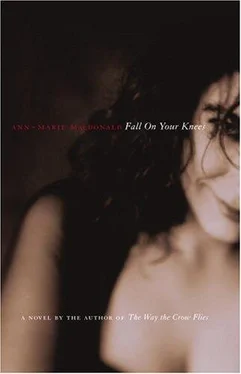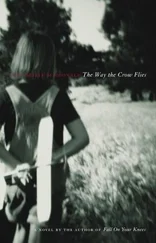Being retired, Giles volunteers at a convent infirmary, where she helps old nuns to die. Her highest qualification for this calling is not her compassion, or her surprisingly strong stomach, or even her piety. It is her unshockability. Giles has lowered her ear to many a withered mouth and heard confessions no priest ever has — for towards the end there is often confusion; a sudden disquiet lest one has after all confessed and repented of the wrong things in life. Ancient sins bloom afresh, fragrant with the purity they possessed a moment before they were named and nipped in the bud. And having listened, Giles may remark, “I know, dear.” Sometimes the dying words come in the form of a question to which Giles may reply, upon reflection, “I wonder that myself, dear, from time to time, truly I do.” But Giles never asks any questions herself.
All of which makes Giles a pretty poor chaperone for a young champion like Kathleen.
That first night in Giles’s guest-room, which overlooks the roofs of the Village and affords a view of the tallest buildings on earth, Kathleen opens a fresh new Holy Angels notebook and writes on the virgin page:
8 pm, February 29, 1918, New York City
Dear Diary …
She keeps her appointment the next day, at the corner of 64th Street and Central Park West in a fifth-floor studio. It is a room of excellent posture. There is a Frenchified sofa that is apparently not for sitting. To the right of the door stands a bust of Verdi atop a marble column. To the left is Mozart. On the gleaming parquet floor, a Persian carpet. A high coffered ceiling in mahogany, a giant window onto the park, a grand piano. An immaculate wheat-coloured man with a goatee, morning coat, tapered trousers and striped cravat. The maestro. From somewhere in Europe. Brief introductions, she is not invited to be seated, she is instructed to sing something.
She does.
It’s a small room. It’s a big voice.
The maestro’s gaze alights on a corner of the carpet, disinterested as an insect, and stays there for the duration of the song. Kathleen finishes. The maestro glances up and perceives the flush on her face, the moist glistening of her eye, the pulse at her neck, her lips still parted. And he says in a wafer-thin voice, “We have a lot of work to do.”
Corruption hangs in the air around a great talent. Such a gift is unstable by nature, apt to embarrass its handlers. About her there is the whiff of the entertainer. Like vaudeville nipping the heels of grand opera. The maestro smells all this on Kathleen and cools his blood to a temperature undetectable by wild animals. Before him lies a gruelling task. It is so much easier to shape competence. Yet, in a small spot beneath the hardest part of his skull, the maestro is feverish with excitement. You don’t get a student like this every day — perhaps two in a lifetime. He prepares to show her no mercy.
As Kathleen works harder and harder, she walks farther and farther. Between sadistic singing lessons with the maestro and suffocatingly sedate suppers with Giles, Kathleen walks the length and breadth of the Island of Manhattan. From the East River to the Hudson; from Battery Park to the Haarlem River.
One day, a girl is sitting at the maestro’s grand piano when Kathleen drags herself up to the studio. She is Rose, in a pale pink dress perfect for a dear little thing with an open face and a trusting nature, and therefore all wrong on Rose.
Rose is an extremely good pianist, but Kathleen doesn’t notice that at first, for two reasons. First, because when you’re training with a famous bastard in New York City, with one eye on the Met and the other on obscurity, you don’t notice the quality of the piano accompaniment during your lesson unless it is incompetent. But this pianist is doubly inaudible because she is black and therefore outside any system that nurtures and advances a classical virtuosa. So Kathleen thinks of Rose not as a pianist but as an accompanist.
When Rose looks at Kathleen the first time, she sees a daughter of fortune and looks back down at her piano keys. When she looks the second time it is to verify that the sound that just filled the room really came from that milk-fed thing standing on the carpet. The voice is worth considering. The singer can go to hell.
“The piano is out of tune,” says Kathleen.
Ordinarily, Kathleen says nothing during her lessons. She makes the sounds the maestro orders her to make and, in the privacy of her own mind, thinks up a thousand devastating retorts with which to slay him. But today she is impelled to speak, because what’s the good of an accompanist if she can’t even hear when the piano is off key? Kathleen has addressed her observation to the maestro, but Rose addresses Kathleen, “The piano is perfectly in tune. You’re flat.”
Kathleen glares at the accompanist, with equal parts fury and disbelief. And the accompanist looks back — calm, level gaze. Insolent, more like it, how dare she? Handsome features cut like sculpture into her face, so at odds with the puffed sleeves and schoolgirl braids. Kathleen looks away dismissively from the beanpole in a hand-me-down dress. She expects the maestro to scold the accompanist or, preferably, fire her. But instead he turns to Kathleen. “Perhaps if you were less intent upon making noise, and more intent upon listening, you might learn to hear the difference between that” — the maestro jabs at a piano key — “and this” — the maestro makes a horrible honking sound through his nose, supposedly in imitation of Kathleen.
Kathleen floods crimson. The maestro instructs her coolly, “Lesson One: The Scale.” Lesson One! Kathleen takes a breath and steadies herself for the giant step backwards. She pictures a shining sword sharp at both edges, and sings the scale, pondering all the while who is worse: Sister Saint Monica, or this singing teacher whom she has come to think of as the Kaiser. And before she is halfway through the scale, she decides: the accompanist is worse.
Rose plays the scale and watches the singer. Decides she is not white, not even red. But green. Faintly visible, called up by outrage, are the veins at her wrists, neck, temple. This is the only physical detail that corroborates the voice, which Rose knows to be not of human origin. The green must be seaweed. Rose allows her mind to wander in this way whenever she is required to play in harness. It helps take the sting from the bit. Rose has no need of fancy when she plays her own music, because there is no difference between her own music and her mind. All alone after hours in a second-storey church in Haarlem, far north of this studio. Free rein.
But for now: Lesson One — La Scala . Kathleen glowers at the accompanist. Rose blinks at the singer and allows the slightest bit of curiosity to mingle with scorn.
It’s 1918. New York City is inching towards the centre of the universe. Its streets throng with working girls and doughboys and the gumption of immigrants from the four corners of the earth. Kathleen is sorely tempted to cut her classes, her hair and her hems. She has forgotten all about the “fashionable New York” of Harper’s Bazaar . She is consumed by the new New York, which is more various and fabulous at two in the afternoon on Mulberry Street than come midnight at the Ziegfield Follies. In Manhattan’s north end Rose plays her own music, while outside her church window Haarlem is turning into Harlem. Rose’s mother has raised her to be an example to The Race, and every day the list of places Rose must never set foot in grows longer. But Kathleen is subject to no such restrictions. Her father is far away, and Giles asks no questions except to enquire, “How are you enjoying New York, dear?”
First Kathleen fell in love with New York. Then she fell in love with a New Yorker. It happened very quickly, the way things are supposed to happen when you move from New Waterford to New York at eighteen.
Читать дальше












